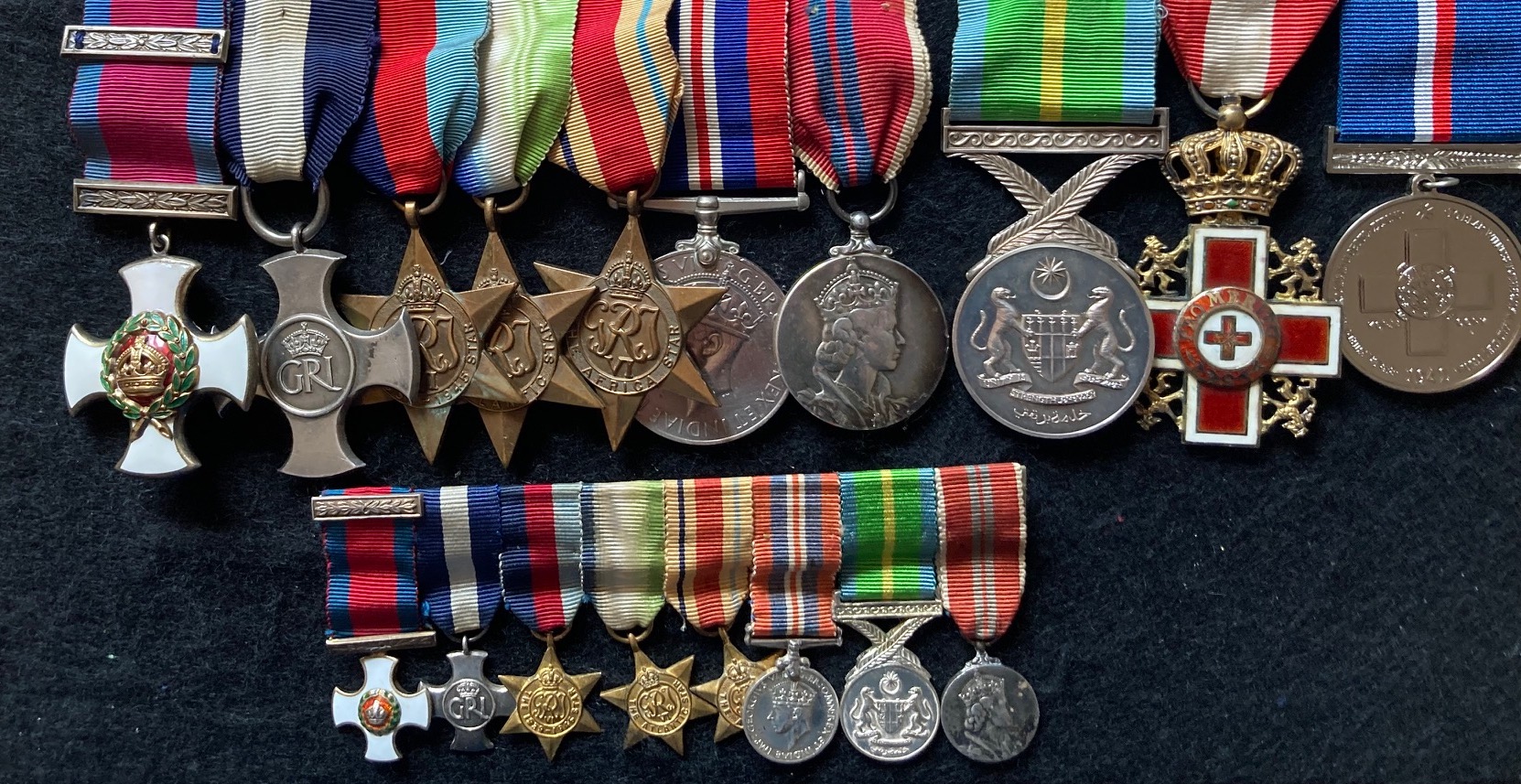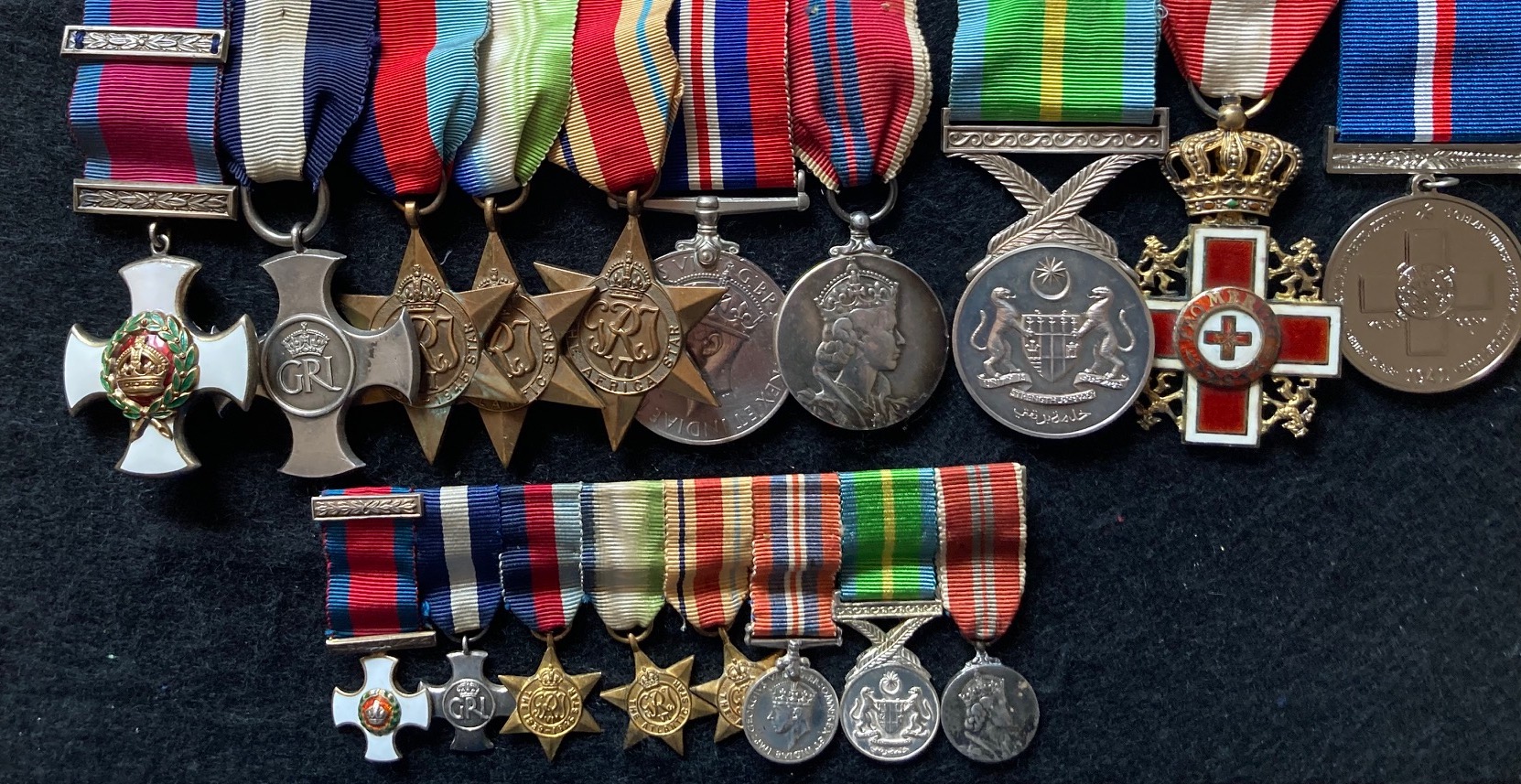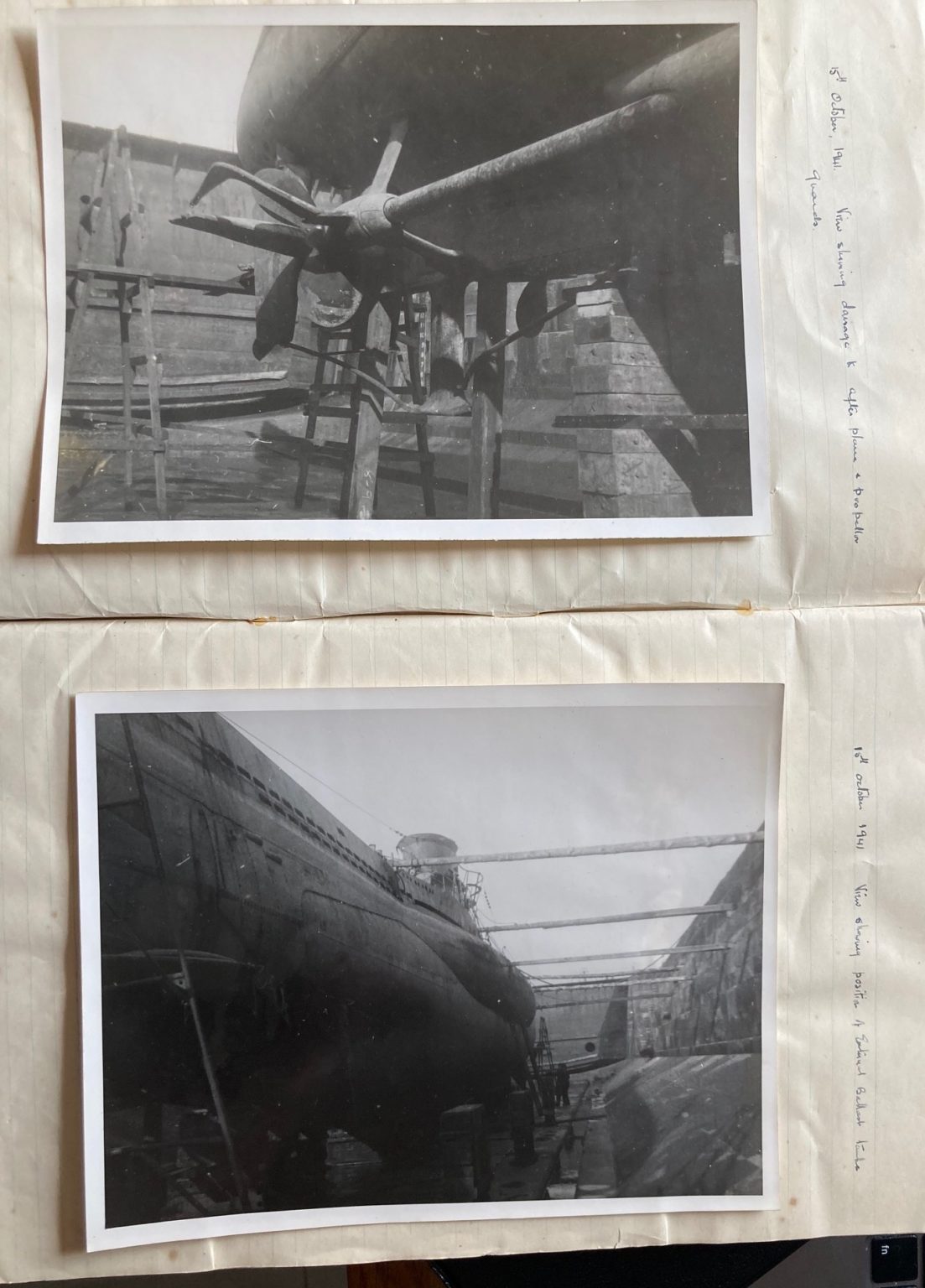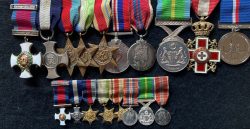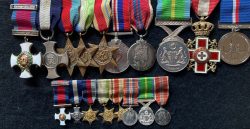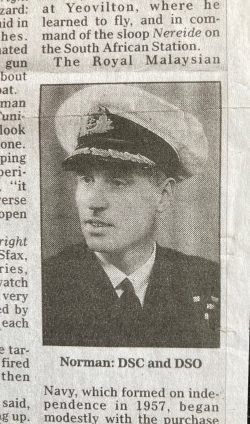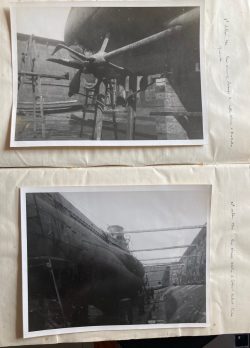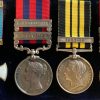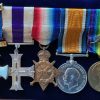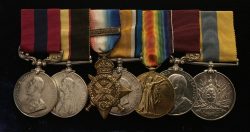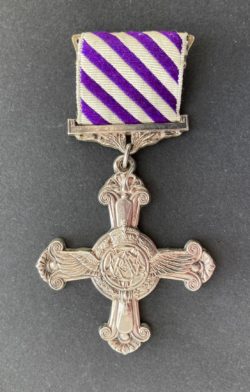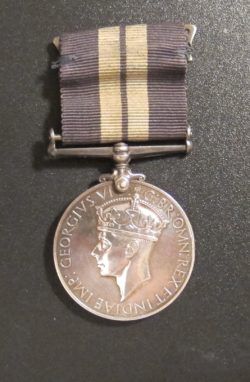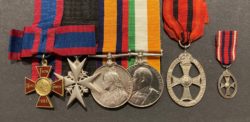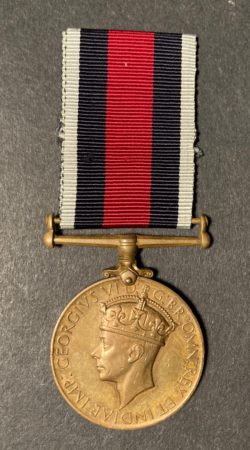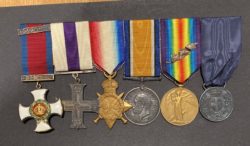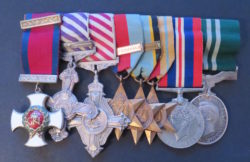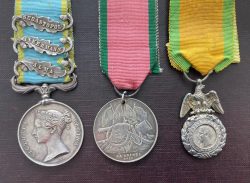A fine Second War submariner’s D.S.O. and D.S.C. group Captain , Royal Navy, who won the D.S.C. when in command of H.M. Submarine H.44 for sinking shipping off the coast of Norway in 1940, and the D.S.O. when in command of H.M. Submarine Upright for sinking the Italian cruiser Armando Diaz in February 1941, despite an escort of Italian destroyers which then launched a search and attack for over an hour, Uniquely. He commanded H.M.S. Graph, previously the U.570 which was captured al most intact at sea by an R.A.F. Hudson aircraft. he was afterwards the first Commodore (commanding) Malaysian Navy
£6,800.00
Out of stock
Distinguished Service Order, (GVI), silver-gilt and enamel, reverse officially dated 1941, with top ribbon bar, Distinguished Service Cross, (GVI), dated 1941, (hallmarks for London 1940), 1939/45 Star, Atlantic Star;, Africa Star;, War Medal , 1953 Coronation Malaysia, Pingat Khidmat Berbakti, Netherlands, Red Cross Decoration, silver-gilt and enamels, Also a Malta Commemorative Medal
With mounted group of eight miniature dress medals, mounted as originally worn
Captain Edward Dudley Norman, R.N. & Commodore, Royal Malayan Navy
Also with, Sold with original warrant and statutes for D.S.O., award certificates for Coronation Medal and Netherlands Red Cross Decoration (16 January 1959), various original correspondence, an original photograph album compiled by Norman with 15 large black and white photographs of the captured U.570 on later trials as H.M.S. Graph, some captioned and dated 15 October 1941, showing interior images and various detailing around her, together with four larger loose photographs of the submarine. Also a fair quantity of original letters to Captain Norman including several relating to his claim for the Malta Commemorative, others to his wife and executors. Additionally a 9 page typed memoir regarding his service with the ‘Fighting Tenth’ during his service during the defence of Malta.
Originally came to the market as part of a family collection, Norman, father, son and one or more others. Later split (not by us), Norman was later separately sold as a group containing a 1977 Jubilee (actually his sons) a Dutch ladies bow Red Cross Merit Medal (possibly wife) and a Danish Galathea Deep sea Expedition medal 1950-52 (who knows who’s but seems totally unconnected to Norman ).
D.S.O. L.G. 23/9/1941. Seedie’s Submarine roll confirms award ‘For sinking the Italian Cruiser Armando Diaz off Kerkenah Bank in the Mediterranean on 25 February 1941, and a supply ship.’
D.S.C. London Gazette 1 January 1941. Documented as an award for a torpedo attack on a 5,000 ton
Edward Dudley Norman was born on 2 August 1910, and went to Dartmouth in 1924. He joined the Submarine service in 1932 and served in submarines at Devonport, Gosport and Portland before undergoing the Submarine C.O.’s Qualifying Course in 1940. His first submarine command in March 1940 was the 1920-vintage H.44, in which he carried out several patrols in the North Sea, sank enemy shipping off the Norwegian coast, and was awarded the D.S.C.
In December 1940, Norman went out to the Mediterranean to take command of Upright in the Malta-based flotilla, later dubbed ‘The Fighting Tenth’. Sailing for his second patrol in February 1941, Upright had to encounter a new hazard: Italian acoustic mines laid in the harbour approaches. Upright’s sailors detonated them by firing machine gun bullets into the water about 100 yards ahead of the boat.
On 21 February, Norman took Upright inside the Tunisian harbour of Sfax to look for targets, but found none. “As we were then scraping along the bottom at periscope depth,” he said, “it seemed prudent to reverse course and retire to the open sea.” Four nights later, Upright was on the surface off Sfax, charging main batteries, when the officer of the watch sighted “a cruiser or a very large destroyer, escorted by two destroyers, one on each bow”.
From ‘ Up Periscope’ Masters 1942
‘There is one patrol in February, 1941 which Lieutenant Commander Norman will never forget. The second night after leaving his base at Malta he sighted a tanker of 3,000 tons trying to run the gauntlet to replenish Axis oil supplies in North Africa. She proved to be the Fanny Brunner, and he crept to within 750 yards of her before firing two torpedoes. He saw one torpedo hit, watched the first burst of flame which quickly enveloped the whole ship. The burning oil burn poured out until the Fanny Brunner was floating in a sea of fire, a most awe-inspiring sight. It cast such a glare that he was forced to dive to avoid the attention of other ships. But the tanker was not escorted, and he was able to give the crew a sight of her burning through the periscope. The biggest bonfire they had ever seen, she burned for an hour and a half before she sank.
A greater success came to Lieutenant Commander Norman on the following night. The submarine was running on the surface when the officer of the watch sighted some ships about three miles away at 2.30 a.m. It was a starry night, and the sea was smooth. Though his binoculars the captain made out an Italian cruiser, the Armando Diaz, steaming at seventeen knots with an escort of three destroyers. She was but 1,000 yards away when he gave the order to fire the torpedoes. As he turned off his tracks to go down, the officer in charge of the attack instruments, despite the fact that they were moving under helm, was able to give the exact bearing on which the cruiser lay, and he raised his periscope just in time to see one of his torpedoes hit. With three destroyers almost on him, it was unhealthy so he dived to the bottom and started to crawl away. For an hour they tried to blast him to bits, but they never came too close eventually their attacks ceased.
By dawn , when the submarine was six miles from the scene of the attack, Lieutenant Commander Norman raised the periscope. The Armando Diaz was no longer afloat, but two destroyers were busy picking up survivors.
That was how Lieutenant Commander Norman won his D.S.O. while his fine work in torpedoing a supply ship of 5,000 tons brought him the D.S.C.’
The 6 in cruiser Armando Diaz was hit by two of the four torpedoes that HM/Sub Upright fired at her, resulting in catastrophic explosions in her magazine and boiler rooms, leading to rapid sinking. Over 500 sailors were lost with her, and only 153 men were rescued. Ascari was also near-missed, and she proceeded to attack HM/Sub Upright without results. The wreck was discovered in 2009 off the Kerkennah islands, in 50 meters with her bow blown off.
Additionally Norman had three days earlier, on 22 February torpedoed and sunk the Italian Ttransport Silvia Tripcovitch.
Invalided home from Malta with dysentery in July 1941, he took command, in October, of the German U-boat U.570, which had surrendered to an R.A.F. Hudson aircraft south of Iceland in August, and was renamed H.M.S. Graph.
U.570’s cryptographic material had been ditched and many instruments smashed, but in a year’s trials under Norman, Graph gave the Allies priceless information about the construction, performance and weaponry of the standard Type VII U-boat. After Graph, Norman commanded Tuna and Alcide, one of the first of the long-range A Class patrol submarines intended for the Pacific.
By the end of the war Norman had commanded six submarines and had carried out a total of 17 war patrols.
Norman left the Submarine Service in 1947 and had appointments in the Admiralty, with Nato, as Executive Officer of H.M.S. Heron, the naval air station at Yeovilton, where he learned to fly, and in command of the sloop Nereide on the South African Station. The Royal Malaysian Navy, which formed on independence in 1957, began modestly with the purchase of a handful of ex-Royal Navy minesweepers. But as its first Commodore, Norman laid the foundations of a small but efficient force which played a full part in the confrontation with Indonesia in the 1960s. When Norman retired in 1960, he was awarded the Malaysian decoration, the Pingat Khidmat Berbakti.
In retirement, Norman was secretary of the Royal Malta Yacht Club, and he played an influential role in establishing the first Whitbread Round the World Race. He died in 1998, aged 87.
Super submarines group
